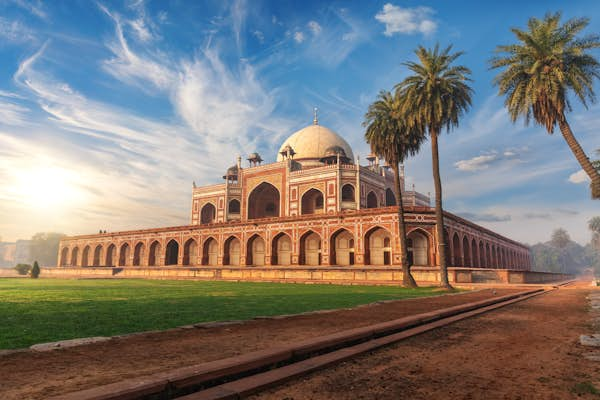The world’s seventh largest nation, India is vast and varied, stretching 3214km (1997 miles) from the snow-capped peaks of the Himalayas to the tropical jungles and dry plains of the south. Needless to say, that’s a lot of subcontinent to fit into one trip!
If this is your first time in India,
consider focusing on a smaller area and exploring in depth, rather than
traveling the length and breadth of the country. The week-long circuit
linking Delhi, Agra and Jaipur is a great way to get a taste of India’s
highlights before setting off to less explored corners.
Known as the Golden Triangle, this looping route will take you from India’s historic capital city, with its Mughal monuments and medieval markets, to the desert city of Jaipur, the seat of one of India’s most flamboyant regional dynasties, and Agra, home to the magnificent Taj Mahal.
Traveling by train, you’ll get a front-row view of India’s captivating landscapes, with rewarding detours to temple towns and a chance to rumble through the hills by jeep to spot tigers in legendary Ranthambhore National Park.
When to arrive
Northern India is affected by the summer monsoon, which brings high temperatures and heavy rain from June to September. The best time to visit is from October to March, when temperatures are lower and skies drier, but this also means peak season crowds and higher prices for transport and hotels.
Advertisement
There’s also a risk of winter fog, which can delay flights and train departures, and nighttime temperatures can feel downright chilly in the desert from December to February. Avoid the months of April and May, when peak temperatures can soar above 40°C (104°F).

How to get around
Traveling long distances by bus or car in India can be slow and uncomfortable, thanks to uneven road surfaces and heavy traffic. It’s more fun to speed through the landscape by train, with the added perk of vendors selling meals, snacks and drinks.
Before you arrive, pre-register to use the online booking system for Indian Railways, administered by the Indian Railways Catering & Tourism Corporation (IRCTC). Once registered, you’ll be able to book and change tickets, check platforms, and confirm departure and arrival times. The invaluable Man in Seat 61 website will talk you through the registration process.
Explore the stops on this itinerary on foot, or by auto-rickshaw or taxi – you may need to agree a fare before the journey starts as drivers are often reluctant to use the meter. Using Uber and Ola can be a handy way to avoid ramped-up fares, but you’ll need an Indian number for your cell phone.
What to pack
Bring sturdy footwear, plus some sandals or flip-flops to kick off when entering mosques and temples. Pack light, loose-fitting cotton clothes that are suitable for the daytime heat, plus a warm layer for nights in the desert and an umbrella in case of showers. Be sure to carry clothes that cover your upper arms and legs for trips to sacred sites.
Other essentials include sunscreen and a sun hat, plus plenty of memory cards for your camera – you’ll be taking a lot of pictures! And visit your doctor a month before you travel to make sure you’re up to date with your vaccinations and have the right anti-malarial medication.

Day 1: See Mughal marvels in Delhi
How to spend the day: Start your first day in Delhi at the Red Fort, where delicate Mughal pavilions and ceremonial reception halls stand behind iconic red sandstone wall that once held back besieging armies. The Victorian-era barracks erected by the British have been converted into museums and temporary exhibition spaces, providing an excellent introduction to Delhi’s heritage and history.
Enjoy a lunch of Delhi’s famous street food along Chandni Chowk, the ancient bazaar that was the focal point of Shah Jahan’s medieval city. Essential stops include Jalebi Wala for Delhi’s finest jalebis (deep-fried, syrupy dough whorls), Natraj Dahi Balle Corner for dahi bhalle (lentil balls with yoghurt and chutney) and aloo tikki (spiced potato patties) and the parathas (buttery flatbreads) served on Paranthe Wali Gali.
Devote the rest of the afternoon to the bazaars of Old Delhi. Little has changed in centuries in the atmospheric, labyrinthine Spice Market (Khari Baoli), where porters hustle through the narrow lanes with huge packages of herbs and spices.
Wander the back alleyways to reach the Jama Masjid, Delhi’s most magnificent Mughal mosque. Built between 1644 and 1658, this was Shah Jahan’s final architectural triumph. Two minarets rise 40m (131ft) above the streets, and one can be climbed for epic views over the city rooftops.
Evening: In the bazaars, long-established Karim’s remains Delhi’s favorite Mughlai kebab and mutton restaurant. Alternatively, go for dinner in British-built Connaught Place – try Hotel Saravana Bhavan for fabulous dosas (rice and lentil pancakes) and other South Indian delights, or try one of the elegantly faded restaurants around the inner circle. Afterward, stop in at Dr Zombie or Lord of the Drinks for cocktails.

Day 2: See more of Delhi
How to spend the day: As the site of no less than eight ancient cities, Delhi offers a lot to see. Set aside the morning for the sights of British-influenced New Delhi, particularly the National Museum, the Agrasen ki Baoli stepwell, and the wonderful astronomical objects of the Jantar Mantar observatory.
Alternatively, see the sites where momentous history unfolded at the Indira Gandhi Memorial Museum, where the controversial Indian leader was assassinated by her bodyguards, and Gandhi Smriti, where Mahatma Gandhi was murdered after campaigning against intercommunal violence.
Grab lunch in the restaurant by the peaceful, tomb-studded Lodi Garden, then head east to the marble and sandstone tomb of the Mughal emperor Humayun – one of India’s most marvellous medieval structures. Nearby, tucked into the tangled lanes of Nizamuddin, is the tomb of the 14th-century Muslim Sufi saint Hazrat Nizamuddin, surrounded by bazaars selling rose petals, perfumes and offerings.
Advertisement
For something more ambitious, ride the Delhi Metro south to reach the UNESCO-listed Qutb Minar, constructed by the Turkic sultan Qutb-ud-din Aibak after he rampaged into town in 1193. The ruins span mosques and tombs and a towering, script-covered minaret – the 73m-high (240ft) Qutb Minar itself. Don’t miss the adjacent ruins of Mehrauli – a vast collection of tombs, mosques and monuments spilling into the forest.
Head back to the center before the shops close to grab some Delhi souvenirs from the hip boutiques surrounding the dramatic parkland ruins of Hauz Khas or the charming government-run state emporiums on Baba Kharak Singh Marg.
Evening: When night falls, go all out for flavor and take a taxi to Indian Accent in the Lodhi Hotel – widely regarded as Delhi’s best restaurant – where chef Manish Mehrotra works magic with seasonal ingredients.

Day 3. Travel to Jaipur
Go from Delhi to Jaipur: Many people head straight to Agra, but we recommend going west to Jaipur. The early morning Ajmer Shatabdi Express will get you to Jaipur’s conveniently central train station by mid-morning, or you could take the fast Vande Bharat Express the evening before.
How to spend the day: Jaipur is well worth two days of your time, so check into your hotel and grab lunch amidst the pink-stone streets of the Old City at Laxmi Misthan Bhandar – an air-con eatery and sweet shop that serves great veg thalis (plate meals).
Take a bus or auto-rickshaw to reach the wonderful Amber Fort just north of town – it’s almost a fortified city, enclosed by invader-repelling yellow and pink sandstone walls that gaze over Mughal-style gardens, ancient stone temples and a crocodile-infested lake.
The most striking structures inside are the Diwan-i-Am, where dignitaries held meetings with the Maharaja, and the Jal Mandir, where the royal family lived a life of gilded luxury. Don’t miss the maze-like royal apartments, where hidden passageways lead to secret chambers with lace-fine fretwork windows overlooking the palace courtyards.
Be sure to check out the lavishly ornamented Ganesh Pol gateway, topped by an image of the eponymous deity, and wander the lanes of the village outside the fort walls, home to numerous carving-covered temples. The ridge above Amber Fort is dominated by the imposing Jaigarh fortress, where the royals retreated when Amber was in danger.
Evening: Make a booking ahead to dine at the rooftop Peacock Restaurant at the Hotel Pearl Palace. It’s phenomenally popular, the food is excellent, and there’s often live Indian classical music.

Day 4: See more of Jaipur
How to spend the day: Get an early start on your second day in Jaipur. Begin at the pilgrim-thronged Govind Dev Ji Temple behind the City Palace, then wander east to visit the extraordinary 18th-century Hawa Mahal (also known as the Palace of the Winds) – an extraordinary gingerbread house of a residence, fronted by a delicate honeycomb of fretwork and stained-glass windows that allowed the ladies of the royal household to peek out at the jostle of city life.
Around the corner is the Jantar Mantar – a giant astronomical laboratory, constructed in 1728 on the orders of the scientifically curious Jai Singh II. Stairs to nowhere climb over calibrated crescents, dangling rings function as astrolabes, and marble-lined basins allow precise calculations of the movements of the spheres.
Use the afternoon to explore the lavish City Palace, still partly used as a residence by the royal family. Have lunch at the palace’s elegant Baradari restaurant, then visit the Mubarak Mahal, a stylistic stew of Islamic, Rajput and European ideas, and the Photography Gallery, which includes snaps taken by Sawai Ram Singh II in the 19th century.
Tour the bristling armory and the marble-covered Diwan-i-Khas where the Maharaja met his ministers, and snap the classic Jaipur photograph in Pitam Niwas Chowk – an open courtyard flanked by four gloriously painted gates representing the seasons.
Evening: If your budget will stretch to it, book dinner at Suvarna Mahal, the elegant, Renaissance-style dining room at the Rambagh Palace hotel, which serves an Indian menu fit for royalty.

Day 5: Embrace spirituality in Ajmer and Pushkar
Go to Ajmer and Pushkar: It’s only two hours by train from Jaipur to Ajmer, and a short trip onward by bus to Pushkar. A day trip from Jaipur is the most convenient option for onward travel the following day, but you can also stop over in Pushkar’s many cozy hotels and guesthouses.
How to spend the day: At the heart of old Ajmer, the Khwaja Muin-ud-din Chishti dargah is thronged at all hours by Muslim devotees, who gather here to pray, contemplate, study the Quran, sing devotional qawwali hymns, and make offerings of rose petals, scarves, incense and sandalwood.
Visitors are welcome, but respect is key. Remove your shoes, cover your head, leave your bag and camera in the cloakroom, and join the crowds of devotees, who will carry you forward like a living wave. Leaving a donation is also appropriate.
Wander the surrounding bazaars – the alleyways around the dargah are crammed with stalls serving tandoori chicken and kebabs and shops selling sweet sohan halwa – the city’s favorite sweet treat. Head southwest to admire the towering arches of Adhai-din-ka-Jhonpra, an ancient 12th-century mosque adorned with Islamic calligraphy.
A short bus or auto-rickshaw ride will take you to the holy town of Pushkar, which hosts a legendary camel market every November. At other times, attention is focused on the sacred lake, flanked by 52 ceremonial bathing ghats where pilgrims perform colourful puja (prayer) rituals. In the surrounding bazaars, crammed with shops targeting hippy travelers and pilgrims, you can visit one of India’s only Brahma temples.
Evening: If you stay in Pushkar, grab dinner at Out of the Blue in the bazaars, or Sixth Sense, the rooftop restaurant at Inn Seventh Heaven.

Day 6. Seek tigers in Ranthambhore National Park
Go to Ranthambhore National Park: Trains can whisk you from Jaipur to Sawai Madhopur, the junction town for tiger-stalked Ranthambhore National Park, in two to three hours. Leave early in the morning for an afternoon safari, or travel the night before for a safari at dawn.
How to spend the day: Rising above Sawai Madhopur, Ranthambhore National Park teems with wildlife, including huge numbers of deer, antelopes, monkeys, and birds of prey, but the 88 resident tigers can be elusive. Safari operators are granted access to safari zones on a rotating roster, with some zones offering easier sightings than others.
Any of the hotels strung out along the road to the park entrance can arrange safaris, but make contact a day ahead to confirm arrangements. A dawn safari by 4WD will give you the best chance of sightings; tigers are less active in the afternoon. On the fringes of the reserve, atmospheric Ranthambhore Fort attracts a constant influx of pilgrims, who come here to pay their respects at an ancient Ganesh temple inside the walls.
Evening: Most people eat where they stay – Hotel Ranthambhore Regency is a good option for both – but the cozy and informal Manisha Restaurant on the national park road serves simple, tasty veg curries.

Day 7: Head to Agra to see the Taj
Go to Agra: Trains roll regularly from Sawai Madhopur to Agra, taking four to seven hours. To maximise your time in Agra, take one of the fast trains leaving around 5am.
How to spend the day: Agra is rightly famous as the home of the Taj Mahal, and you’ll need at least half a day to explore this magnificent tomb and its gardens. A gleaming collection of minarets, onion domes and inlaid arches, India’s most perfect monument was constructed by the heartbroken Mughal emperor Shah Jahan in memory of his Mumtaz Mahal, who died in childbirth.
After admiring its perfect symmetry and formal gardens, spend the rest of the day at rambling Agra Fort, the seat of the Mughal court for over a century. Inside its daunting walls lie elegant administrative buildings, lavish palaces, gorgeous gardens, graceful courtyards, audience halls and mosques.
Alternatively, see the Taj then zip to nearby Fatehpur Sikri, the vast, red sandstone city that Akbar created and then abandoned in the 16th century. Wander across centuries in the royal audience halls, the monumental Buland Darwara gateway, and the latticework tomb of the Sufi saint Shaikh Salim Chishti.
Evening: You could head back to Delhi once night falls, but it’s just as easy to take the two to three-hour train ride the next morning. If you do stop over, there’s inexpensive eating in the Old City – Chimman Lal Poori is good for puris (fried puffed bread) with veg sauces, while Mughal Nihari serves tasty, richly spiced nihari stew. For something upmarket, try the hip Salt Cafe Kitchen & Bar for a worldwide menu with a city view.
This article was adapted from Lonely Planet’s India guidebook, published in November 2024.









